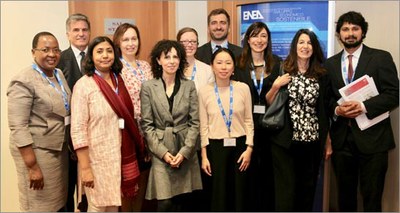Clean energy: New initiative to advance women’s leadership under the International Energy Agency
19/4/2018
 Promoting women in clean energy’s leadership roles is the objective of the collaborative programme Clean Energy, Education and Emporwement (C3E), among the International Energy Agency and Italy, Canada, Finland and Sweden. ENEA, which represents Italy, is part of the Committee and leads the task force on collecting data and setting up indicators for identifying the barriers hindering women from progressing in their careers.
Promoting women in clean energy’s leadership roles is the objective of the collaborative programme Clean Energy, Education and Emporwement (C3E), among the International Energy Agency and Italy, Canada, Finland and Sweden. ENEA, which represents Italy, is part of the Committee and leads the task force on collecting data and setting up indicators for identifying the barriers hindering women from progressing in their careers.
In Italy the share of women entering top political positions, particularly in the Ministries related to the energy field, mostly as Deputy Minister and Under-Secretary, has grown as compared to the 70’s and 80’s, but we are still far from having achieved gender equality in politics.
Additional data on decision making roles attained by women in Parliamentary Commissions involved in energy issues , such as Productive activities, the Environment, Culture and science, Infrastructures and transportation shows that currently women are under-represented at the top echelons- chief (13%) and deputy chief (19%)- while the percentage rises for secretary (44%) and the total commissions members (31%).
As for the entrepreneurial sector, Law 120 /2011 introduced significant changes which favoured the growth of women’s representation. In fact, the law requires that in listed companies one third of corporate boards would be women: a measure which caused the presence of women to grow from 5% in 2007 to 30.9% in 2017, even if the percentage relative to the role of sole administrator is still at 8%.
As regards the main corporate administration and control bodies active in the energy production and distribution sector, women hold 43% of presidential positions but none serves as sole administrator. The percentage relative to Boards of Directors is 35% - surpassing that of listed companies.
There’s lack of a female president also in the sector of public energy research, while women fill 25% of other top positions and the percentage of women on board seats is just 16%, contrary to management groups, such as departments, laboratories and special units, where women account for 22% of managing positions.
“Data collected to date - Tania Giuffrida at ENEA explained- is not consistent with that on university education, which should be at the basis of the career path”.
As concerns Industry Associations operating in the energy sector, there is no woman president, women hold just 19% of leadership positions and women’s presence in management positions is 9%.
In Italy in 2014, in fact, the percentage of women graduate in technical and science areas (commonly known as STEM) was 53% of the total graduates. “Young women-Giuffrida concluded- are likely to achieve a high level of education, a fact which will be worth monitoring in the years to come, considering that the share of women working in the green economy is largely concentrated in the administrative and management sectors, making up 46% and 32% of the workforce respectively, while the numbers are lower in the technical field, approximately 28%.
For more information please contact:
Tania Giuffrida, ENEA – Studies and Strategies Unit, member of the executive committee of C3E, tania.giuffrida@enea.it
Elena De Luca, , ENEA – Studies and Strategies Unit, member of the executive committee of C3E, elena.deluca@enea.it
Elena De Luca on the role of women in clean energy (VIDEO) https://youtu.be/rU0nDt8onsk
